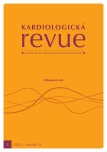The diagnosis of aortic stenosis
Authors:
K. Linhartová
Authors place of work:
2. LF UK a FN V Motole, Praha
; Kardiologická klinika
Published in the journal:
Kardiol Rev Int Med 2013, 15(3): 141-143
Category:
Chlopenní vady
Summary
Aortic stenosis is found in 2.5% of patients aged over 65 years, and in developed countries it is the most commonly corrected valve disease. Our aim was to review the diagnosis of aortic stenosis and its pitfalls. The diagnosis is based on echocardiographic maximal transaortic velocity, mean transaortic gradient and calculated aortic valve area. In case of discordance between the distinctive parameters, further assessment relies mainly on the ejection fraction and stroke volume of the left ventricle. In 2007, the real time three‑ dimensional transesophageal echocardiography was introduced into clinical practice. This method enables three‑ dimensional dataset acquisition of the selected part of the aorta or aortic valve and reliable measurement of dimensions using multiplanar reconstruction of the image. Accurate measurements are crucial for valve prosthesis sizing before transcatheter implantation of the aortic valve, and the three‑ dimensional transesophageal echocardiography provides results that are closest to the computed tomography measurements.
Keywords:
aortic stenosis – real time 3D transesophageal echocardiography – computed tomography – transcatheter implantation of the aortic valve
Zdroje
1. Stewart BF, Siscovick D, Lind BK et al. Clinical factors associated with calcific aortic valve disease. J Am Coll Cardiol 1997; 29: 630– 634.
2. Roberts WC, Ko JM. Frequency by decades of unicuspid, bicuspid, and tricuspid aortic valves in adults having isolated aortic valve replacement for aortic stenosis, with or without associated aortic regurgitation. Circulation 2005; 111: 920– 925.
3. Kang JW, Song HG, Yang DH et al. Association between bicuspid aortic valve phenotype and patterns of valvular dysfunction and bicuspid aortopathy: comprehensive evaluation using MDCT and echocardiography. JACC Cardiovasc Imaging 2013; 6: 150– 161.
4. Baumgartner H, Hung J, Bermejo J. Echocardiographic assessment of valve stenosis: EAE/ ASE Recommendations for clinical practice. Eur J Echocardiogr 2009; 10: 1– 25.
5. Vahanian A, Alfieri O, Andreotti A et al. Guidelines on the management of valvular heart disease (version 2012). The Joint Task Force on the Management of Valvular Heart Disease of the European Society of Cardiology (ESC) and the European Association for Cardio‑ Thoracic Surgery (EACTS). Dostupné z: www.escardio.org/ guidelines.
6. Dumesnil JG, Pibarot P. Low‑ flow, low‑ gradient severe aortic stenosis in patients with normal ejection fraction. Curr Opin Cardiol 2013 [Epub ahead of print].
7. Michelena HI, Margaryan E, Miller FA et al. Inconsistent echocardiographic grading of aortic stenosis: is the left ventricular outflow tract important? Heart 2013; 99: 921– 931.
8. Jander N, Minners J, Holme I et al. Outcome of patients with low‑ gradient ‘severe’ aortic stenosis and preserved ejection fraction. Circulation 2011; 123: 887– 895.
9. Ferda J, Linhartová K, Kreuzberg B. Comparison of aortic valve calcium content in bicuspid and tricuspid stenotic aortic valve using non‑enhanced 64- detector‑ row‑ computed tomography with prospective ECG‑ triggering. Eur J Radiol 2008; 68: 471– 475.
10. Smith LA, Dworakowski R, Bhan A et al. Real‑ time three‑ dimensional transesophageal echocardiography adds value to transcatheter aortic valve implantation. J Am Soc Echocardiogr 2013; 26: 359– 369.
11. Zamorano J, Badano L , Bruce C et al. EAE/ ASE Recommendations for the use of echocardiography in new transcatheter interventions for valvular heart disease. J Am Soc Echocardiogr 2011; 24: 937.
12. Ng AC, Delgado V, van der Kley F et al. Comparison of aortic root dimensions and geometries before and after transcatheter aortic valve implantation by 2- and 3- dimensional transesophageal echocardiography and multislice computed tomography. Circ Cardiovasc Imaging 2010; 3: 94– 102.
Štítky
Dětská kardiologie Interní lékařství Kardiochirurgie KardiologieČlánek vyšel v časopise
Kardiologická revue – Interní medicína

2013 Číslo 3
- MINISERIÁL: Když ženám stoupá tlak...
- Není statin jako statin aneb praktický přehled rozdílů jednotlivých molekul
- Specifika v komunikaci s pacienty s ránou – laická doporučení
Nejčtenější v tomto čísle
- Diagnostika aortální stenózy
- Extrasystoly – Arytmie a možnosti léčby v kontextu chlopenních vad
- Katetrizační implantace aortální chlopně (TAVI) – současnost a novinky v roce 2013
- Několik poznámek k historii kardiochirurgie
